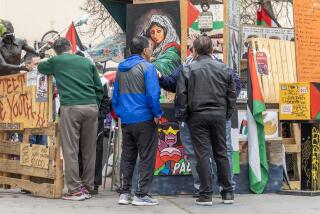An early taste of social activism
- Share via
For Zev Yaroslavsky, the personal has always been political.
Yaroslavsky has represented the western part of Los Angeles County as a member of the Board of Supervisors since 1994. Previously, he served on the L.A. City Council for 19 years. But before he began his life in local politics, Yaroslavky was one of the leading activists in the international movement to free Soviet Jews, who, for many decades, were essentially prisoners in their own country.
The 59-year-old Yaroslavsky talks about his experiences in the movement in Laura Bialis’ new documentary, “Refusenik,” which opened Friday.
Until the fall of the Iron Curtain in 1989, life for Jews in the Soviet Union was grimly oppressive. Word first came to the U.S. in the early ‘60s that the Communist government had closed synagogues and forbidden the study of Hebrew. Soviet Jews were forced to carry internal passports that identified their heritage. Frequently, they were not admitted to universities or permitted to work in certain professions. And when they tried to apply for exit visas, they were fired from their jobs.
Many, however, remained defiant, challenging the government and demanding their freedom. These so-called refuseniks would hold clandestine Hebrew lessons and services, despite the threat of prison or exile.
Meanwhile, grass-roots activists in various countries began picking up their cause, holding protests, lobbying governments to pressure Moscow to change, even smuggling contraband into the Soviet Union to aid refuseniks.
Yaroslavsky caught a taste of what life was like for Jews in the Soviet Union at age 19. It was in summer 1968 when he and his father -- who was born in Ukraine -- visited the country for three weeks.
“The formulative day of my life was when my aunt met me at the airport in Moscow,” Yaroslavsky says. “She showed me around Moscow and Red Square. Here we are in the middle of Red Square and I said to my aunt, ‘Tell me how it is for Jews in the Soviet Union.’ ”
His aunt was terrified by his question.
“She put her index finger up to her lips and said, ‘Shush. The walls have ears.’ Here we were in the middle of this huge square, and she was afraid to talk. That was my visceral introduction to the Soviet Union.”
Upon returning to Los Angeles, the UCLA sophomore formed California Students for Soviet Jews and enlisted his friends to join him. The group’s first major protest was in summer 1969, when Soviet athletes were in town for a track and field meet with the U.S. at the Coliseum.
“I found out the Russian athletes were staying at the USC dormitories,” Yaroslavsky says. “I got a bunch of my friends and I said, ‘Let’s make some picket signs, call the press, and we’ll picket these guys.’ It was a sensation -- TV cameras showed up and the Jewish press did stories. It changed the whole paradigm.”
That fall, Yaraslovsky and a fellow activist, Holocaust survivor Si Frumkin, enlisted newscaster George Putnam.
“I was a flaming liberal and George Putnam was this conservative, right-wing, pro-war . . . he was the personification of political evil to my generation in those days,” says Yaroslavsky. “But he was anti-Soviet and very favorable to Soviet Jews.”
It was Putnam who suggested a candlelight protest march that drew more than 5,000 people, including Mayor Sam Yorty, Councilman Tom Bradley and TV performer Steve Allen on a chilly December night in 1969.
“We repeated it the following year,” recalls Yaroslavsky. “And in 1970, we had over 10,000 people. It took this movement from an insular, talking-to-ourselves movement to taking this issue to the people.”
--



